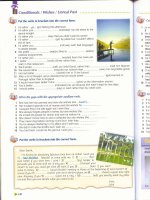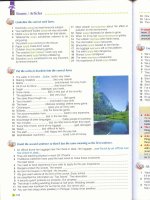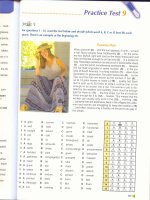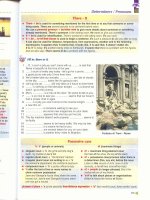FCE use of English 2009
Bạn đang xem bản rút gọn của tài liệu. Xem và tải ngay bản đầy đủ của tài liệu tại đây (117.42 KB, 2 trang )
<span class='text_page_counter'>(1)</span><div class='page_container' data-page=1>
<b>FCE Sample Test</b>
October 2009
<b>FCE Sample Test</b>
<b>Use of English – Part 1</b>
For questions <b>1-12</b>, read the text below and decide which answer (<b>A, B, C</b> or <b>D</b>) best fi ts each
gap. There is an example at the beginning (<b>0</b>).
<b>Example:</b>
<b>0 A</b> known <b>B</b> common <b>C</b> popular <b>D</b> normal
<b>THE MUSTARD SHOP</b>
Norwich, a city in the east of England, is a <b>(0) </b>...<b>C</b>... shopping centre for thousands of people. In
particular, visitors love to <b>(1)</b> ... the small, unusual shops hidden away in Norwich’s narrow
streets. The Mustards Shop is usually high on everybody’s <b>(2)</b> ... of interesting shops to see.
The <b>(3)</b> ... between mustard, a type of sauce, and Norwich <b>(4)</b> ... back to the nineteenth
century. Jeremiah Colman began to make mustard in 1814 in a nearby village. The yellow
fi elds, full of mustard fl owers whose seeds were required for Colman’s factory, soon changed
the appearance of the local <b>(5)</b> ... . The company <b>(6)</b> ... rapidly and in 1854 it moved
to a suburb on the <b>(7)</b> ... of Norwich. By this time, Colman’s mustard was famous in many
countries. The company is still in <b>(8)</b> ... and many people continue to enjoy eating mustard
with meat, cheese and other food.
In 1973, the company opened The Mustard Shop. It is a careful reproduction of a typical mustard
shop of a hundred years ago and sells a wide <b>(9)</b> ... of mustards. Upstairs there is a small
museum where visitors can <b>(10)</b> ... a collection of old Colman’s posters and an exhibition
<b>(11)</b> ... the history of mustard. It is a shop not to be <b>(12)</b> ... when visiting Norwich.
<b>1 A</b> explore <b>B</b> enquire <b>C</b> research <b>D</b> analyse
<b>2 A</b> account <b>B </b>brochure <b>C</b> list <b>D</b> guide
<b>3 A</b> join <b>B</b> tie <b>C</b> union <b>D</b> link
<b>4 A</b> comes <b>B</b> goes <b>C</b> belongs <b>D</b> leads
<b>5 A</b> view <b>B </b>scenery <b>C</b> background <b>D</b> nature
<b>6 A</b> expanded <b>B</b> enlarged <b>C</b> increased <b>D</b> strengthened
<b>7 A</b> limits <b>B</b> frontiers <b>C</b> sides <b>D</b> outskirts
<b>8 A</b> reality <b>B</b> fact <b>C</b> existence <b>D</b> force
<b>9 A</b> amount <b>B</b> extent <b>C</b> range <b>D</b> set
<b>10 A</b> review <b>B </b>watch <b>C</b> examine <b>D</b> remark
<b>11 A</b> explaining <b>B</b> announcing <b>C</b> expressing <b>D</b> discovering
</div>
<span class='text_page_counter'>(2)</span><div class='page_container' data-page=2>
<b>FCE Sample Test</b>
October 2009
<b>Answer key:</b>
<b>Part 1</b>
1A, 2C, 3D, 4B, 5B, 6A, 7D, 8C, 9C, 10C, 11A, 12B
<b>Part 2</b>
13 When, 14 had, 15 great / good, 16 as / for
, 17 each, 18 At, 19 make, 20 not, 21 to, 22 well, 23 way
, 24 whether / if
<b>Use of English – Part 2</b>
For questions <b>13-24</b>, read the text below and think of the word which best fi ts each gap. Use only
<b>one</b> word in each gap. There is an example at the beginning (<b>0</b>).
<b>DICTIONARIES</b>
Dictionaries are <b>(0)</b><i>among</i> the most important tools of self-education. <b>(13)</b> ... Samuel
Johnson wrote his infl uential English dictionary in the eighteenth century, the work kept him busy
for seven years. At the end of that period he <b>(14)</b> ... written the meanings of over forty
thousand words. Most modern dictionaries require a <b>(15)</b> ... deal less time and effort to
write because writers often use earlier dictionaries <b>(16)</b> ... a source of reference.
Nowadays, most dictionaries are put together by teams of writers, or lexicographers. Sometimes
they need to work together in meetings; at other times they work independently of <b>(17)</b> ...
other, on different parts of the dictionary.
<b>(18)</b> ... one time, the starting point for deciding on which words to include used to
be the lexicographer’s own knowledge. These days, teams <b>(19) </b>... use of a large
collections of examples of <b>(20)</b> ... only writing but also everyday speech, which
is known as a <i>corpus</i>. Teams also refer <b>(21)</b> ... books and articles about language as
<b>(22)</b> ... as asking experts in particular subjects about the more specialised words.
Finally, ordinary people are asked to say what they think about the <b>(23)</b> ... the words
</div>
<!--links-->









